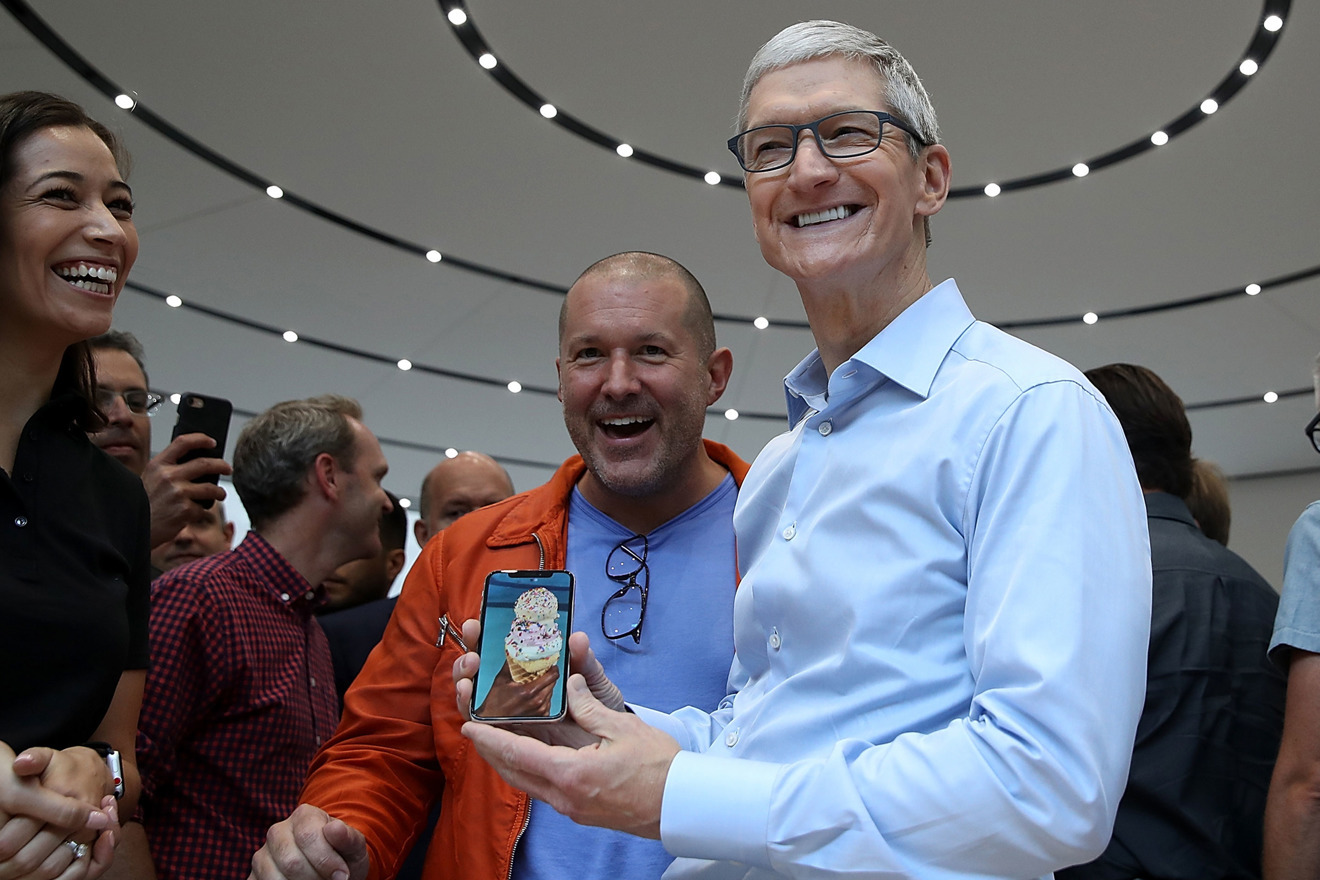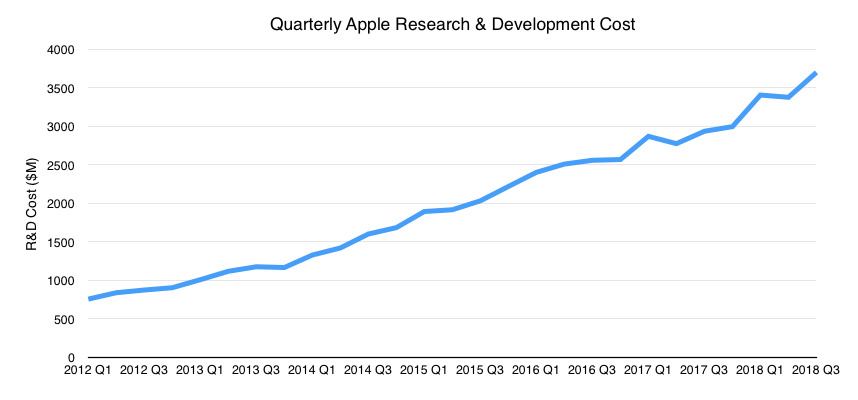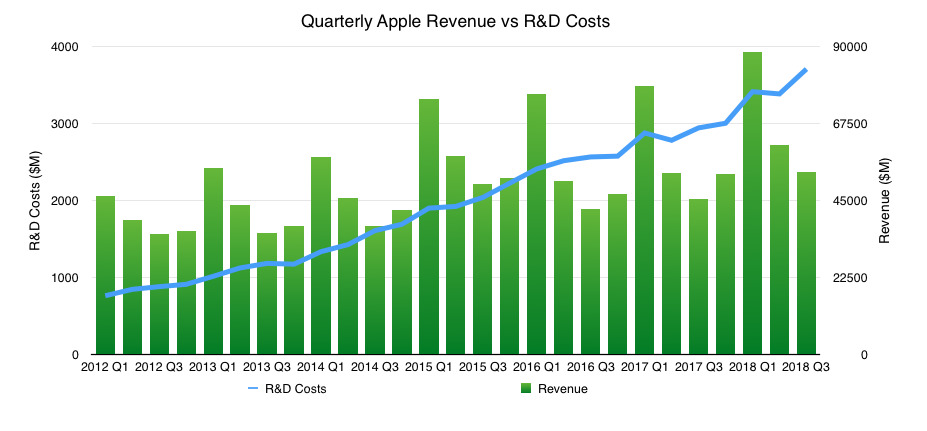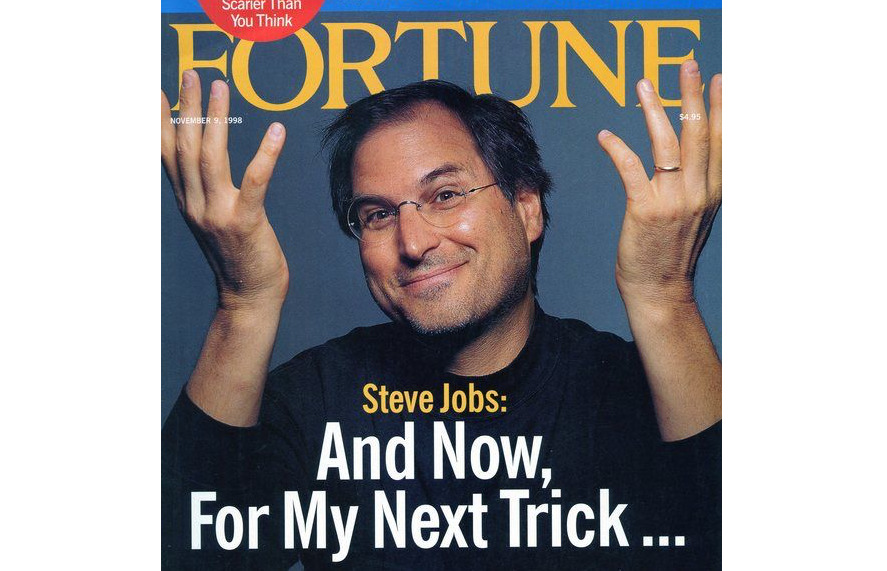The company just increased its research and development budget for about the 15th consecutive year but it's not a direct sign that there are new product categories coming soon.
Every few years, we see a new Apple device like the HomePod, the AirPods, the Apple Watch, and so on back to the iPhone and the iPad. We also see the company spending ever more sums on research and development. Yet what we don't see and it appears we never will is any correlation between these two things. HomePod, for instance, was announced in June 2017 but you can't find a spending hike six months, a year, or even two years earlier.
It's very tempting to try, though, and most especially so this week when Apple announced that it has spent $760 million more on R&D than it did this time last year. That brings this third fiscal quarter's spend to $3.7 billion.
At the same time, we are rumored to see three new iPhones, possibly also new iPads, and perhaps also new Apple Watches before the end of the year. These are still just rumors but they're not the only ones: it's also possible that we'll see new iMacs, a new Mac mini, and hopefully at least a glimpse of the promised Mac Pro.
Even if we get a fraction of these, it's going to be a busy year for Apple. It's easy to assume this is why it has been spending more on research and development but it doesn't appear to be true.
While Apple's earnings have spiked with clear and notable rises in the Christmas periods over the last many years, R&D has just quietly gone about its business.
You can see two spikes around the first quarters of 2017 and 2018. But, they're not big and they are both eclipsed by the steady rise that continued after them.
Given the industry, it's not a surprise that Apple treats R&D seriously. So it's also not a surprise that it would be awarded more funds when those funds are available. What is a surprise is that almost every single one of Apple's major competitors spends more and sometimes much more than it does.
Bernstein Research, a firm that claims to have been ranked first for "Best Knowledge of US Companies and Industries for 14 Straight Years" thinks Apple is doing it wrong.
In a Bernstein analysis reported on by financial site Barrons, Analyst Toni Sacconaghi says: "While Apple's current R&D spending is large, our benchmarking analysis suggests that Apple appears to still be underspending on R&D today, perhaps by a factor of 2x."
There is some backing to the analysis. "We examined Apple and the next 25 largest tech companies," he continued, "and found a somewhat strong correlation between R&D as a percent of revenue and gross margin."
Speaking before this week's results, he said Bernstein estimated that Apple spent 5.1 percent of its revenue on R&D which is less than its rivals. "Apple could double its R&D and be relatively inline with peers".
Back in April in a report specifically about US technology firms, Recode reported that Amazon spent $22.6 billion on R&D last year, up 41 percent from 2016. The same data said Google's Alphabet spent $16.6B.
Then, Intel had spent $13.1B and Microsoft $12.3B. For the same period, Statista.com reports that Samsung spent $12.7 billion.
None of these companies are having the kind of earnings reports that Apple continues to have.
Previously Apple has underspent on R&D compared to every competitor but the fact that it's matched Samsung this time is likely to again to be down to how much money it has to invest. Apple treats R&D seriously — but it famously hasn't thrown money at it.
In 1998, Steve Jobs told Fortune magazine: "Innovation has nothing to do with how many R&D dollars you have."
"When Apple came up with the Mac, IBM was spending at least 100 times more on R&D," added Jobs. "It's not about money. It's about the people you have, how you're led, and how much you get it."
Apple's research and development spending not only does not peak when a new product is imminent, it doesn't dip during the quiet times. It just keeps on funding whatever Apple's working on, at any given moment.
That's the driving force here, the need to spend what needs to be spent in order to achieve whatever product Apple is working on. The company clearly won't double its R&D spend because an analyst says everyone else is. And so far, Apple's approach is working well for it and has been for those 15 years.
 William Gallagher
William Gallagher










-m.jpg)






 Marko Zivkovic
Marko Zivkovic
 Christine McKee
Christine McKee
 Andrew Orr
Andrew Orr
 Andrew O'Hara
Andrew O'Hara


 Mike Wuerthele
Mike Wuerthele
 Bon Adamson
Bon Adamson




-m.jpg)



16 Comments
I'm sure that if you had insight into how those R&D dollars were allocated, there would be tell-tale signs about upcoming product releases. For example, I'm sure whatever type of R&D goes into "wearables" is much higher than it was 10 years ago and grew dramatically as the Apple Watch and AirPods were being developed. But why would we expect the overall R&D budget to predictive of anything? It's not like Apple leadership is thinking "hmm, we should have a new product 3 years from now, go hire 1,000 people" or "Ok, now that Siri is out the door, let's fire all those guys."
What would be fascinating to learn is what's actually part of the R&D numbers. Presumably it's everything from foundational basic science research on various topics to the actual coding of the next version of iOS and the myriad frameworks supported. Plus market research? Designing next generation processors? As Apple gets bigger and sells more products in more domains, R&D will naturally keep rising, with small blips and surges as priorities shift (for example, all the rumors about the on-again-off-again work on self driving cars).
I think judging a company's spending on R&D as a percentage of revenue is stupid. Extreme example: a smartphone startup is spending 100% of its revenue of $1m. AAPL is spending spending 5% on its revenue of $200b. Who do you think is going to come up with more ideas & products?
According to this article, AAPL also lags 4 other tech companies with respect to total spending. But how many markets are these companies in and how complex/costly are these markets? AAPL spends its R&D dollars on a pretty narrow and related set of markets. That saves money. Contrast that to AMZN - R&D in smart warehousing has very little in common with their cloud services R&D :-)
Hope the new iPads with FaceID are finished.
I would like to see better FaceID, an amazing Apple TV to rule all TV products(Gaming, shopping, Exercise, AR etc.)
And next I would like to see their Glasses and a kick@ss soundbar.
...yet.
This is totally asinine.
To put it into historical context it took two really big attempts to build the Panama Canal. The first attempt was an expensive and dismal failure. During the first attempt the builders tried to convey their progress to investors by reporting on how much dirt they were moving (spend). They moved a monumental amount of dirt in attempting to go through the mountains. Then the rainy seasons hit and most of the dirt they'd moved returned from where it had been excavated. The second attempt to build the canal focused on how far they progressed as they went over the mountains. The measure of progress on the successful attempt was always percentage of the canal that was navigable, not how much dirt they were moving.
Another way of saying this is you have to set your milestones and evaluate your success based on your actual progress, not your effort. There is no predictable conversion rate between levels of R&D spending and levels of success in the marketplace. Sure, taking more stabs at solving a problem creates more opportunities for finally hitting on a solution. But you have to both be doing the right things (strategy) and doing things right (execution). If you get either of these things wrong or misaligned - you're screwed and can blow through massive amounts of R&D spending with very little to show for it.
Look where Apple is today versus 1997. Their results and progress are staggering and they have a formidable portfolio of IP, a byproduct of the R part of R&D, that will sustain them for many years to come.
Steve was spot on.